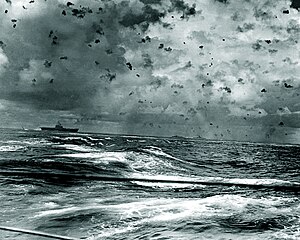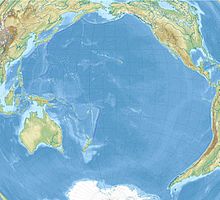
Back معركة جزر سانتا كروز Arabic Bitva u ostrovů Santa Cruz Czech Slaget ved Santa Cruz-øerne Danish Schlacht bei den Santa-Cruz-Inseln German Αεροναυμαχία της Σάντα Κρουζ Greek Batalo ĉe insuloj Santa Cruz Esperanto Batalla de las islas Santa Cruz Spanish نبرد جزایر سانتا کروز Persian Santa Cruzin saarten taistelu Finnish Bataille des îles Santa Cruz French
| Battle of the Santa Cruz Islands | |||||||
|---|---|---|---|---|---|---|---|
| Part of the Guadalcanal Campaign of World War II | |||||||
 USS Enterprise (center left) and her screening ships during the battle, 26 October 1942 | |||||||
| |||||||
| Belligerents | |||||||
|
|
| ||||||
| Commanders and leaders | |||||||
|
|
| ||||||
| Strength | |||||||
|
2 fleet carriers 1 battleship 3 heavy cruisers 3 light cruisers 14 destroyers 136 aircraft[1] |
2 fleet carriers 2 light carriers 4 battleships[2] 8 heavy cruisers 2 light cruisers 24 destroyers 199 aircraft[3] | ||||||
| Casualties and losses | |||||||
|
266 killed[4] |
400–500 killed[5] | ||||||
Location within Pacific Ocean | |||||||
The Battle of the Santa Cruz Islands, fought during 25–27 October 1942, sometimes referred to as the Battle of Santa Cruz or Third Battle of Solomon Sea, in Japan as the Battle of the South Pacific (Japanese: 南太平洋海戦 Minamitaiheiyō kaisen), was the fourth aircraft carrier battle of the Pacific campaign of World War II. It was also the fourth major naval engagement fought between the United States Navy and the Imperial Japanese Navy during the lengthy and strategically important Guadalcanal campaign. As in the battles of the Coral Sea, Midway, and the Eastern Solomons, the ships of the two adversaries were rarely in sight or gun range of each other. Instead, almost all attacks by both sides were mounted by carrier- or land-based aircraft.
In an attempt to drive Allied forces from Guadalcanal and nearby islands and end the stalemate that had existed since September 1942, the Imperial Japanese Army planned a major ground offensive on Guadalcanal for 20–25 October 1942. In support of this offensive, and with the hope of engaging Allied naval forces, Japanese carriers and other large warships moved into a position near the southern Solomon Islands. From this location, the Japanese naval forces hoped to engage and decisively defeat any Allied (primarily U.S.) naval forces, especially carrier forces, that responded to the ground offensive. Allied naval forces also hoped to meet the Japanese naval forces in battle, with the same objectives of breaking the stalemate and decisively defeating their adversary.
The Japanese ground offensive on Guadalcanal was underway with the Battle for Henderson Field while the naval warships and aircraft from the two adversaries confronted each other on the morning of 26 October 1942, just north of the Santa Cruz Islands. After an exchange of carrier air attacks, Allied surface ships retreated from the battle area with the fleet carrier Hornet sunk, and another fleet carrier, Enterprise, heavily damaged. The participating Japanese carrier forces also retired because of the Japanese army’s failure to capture Henderson Field.
Santa Cruz was a tactical victory for the Japanese in terms of both tonnage and control of the seas around Guadalcanal. However, Japan's loss of many irreplaceable veteran aircrews proved to be a long-term strategic advantage for the Allies, whose aircrew losses in the battle were relatively low and were quickly replaced. The Japanese had hoped for, and needed, a larger, decisive victory. The fact that the naval battle was won just after the land battle was lost meant that the opportunity to exploit their victory in the battle had already passed.
- ^ Frank, Guadalcanal, p. 373. Breakdown of aircraft by type: 63 Grumman F4F Wildcats, 47 Douglas SBD Dauntless, and 26 Grumman TBF Avengers. The "136" number doesn't include Boeing B-17 Flying Fortresses based at Espiritu Santo (who played a small part in the battle) or any seaplanes in the area.
- ^ Kongō, Haruna, Hiei, Kirishima. See "Order of Battle – Battle of the Santa Cruz Islands". Retrieved 21 September 2009.
- ^ Frank, Guadalcanal, p. 373. Breakdown of aircraft by type: 87 A6M Zeros, 68 Aichi D3A dive bombers, 57 Nakajima B5N torpedo bombers, and one Yokosuka D4Y command and control aircraft.
- ^ Frank, Guadalcanal, p. 401; Lundstrom, Guadalcanal Campaign, p. 456. Breakdown of deaths: Hornet 118, Enterprise 44, Smith 57, Porter 15, Pensacola 3, South Dakota 2, Morris 1, and 22 aircrew. Four U.S. aircrew members were captured by the Japanese. Total U.S. aircraft losses included 32 Wildcats, 31 SBDs, and 18 TBFs.
- ^ Frank, Guadalcanal, pp. 400–401; Peattie, pp. 180, 339; and Lundstrom, Guadalcanal Campaign, p. 454. Japanese deaths from damage to Zuihō aren't known. Known Japanese deaths are: 60 on Shōkaku, 190 on Chikuma, seven on Teruzuki, and 148 aircrew. Total Japanese aircraft losses included 27 Mitsubishi A6M Zeros, 40 dive bombers, 29 torpedo bombers, and 1 Yokosuka D4Y. The aircrew losses included 55 from Shōkaku, 57 from Zuikaku, 9 from Zuihō, and 27 from Junyō.
